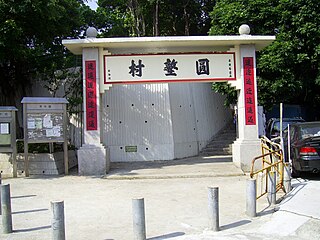
The Tuen Mun District is one of the 18 administrative districts of Hong Kong. As of 2021,it had a population of 506,879. Of these people,64,000 are under the age of 18. Part of the district is the Tuen Mun New Town,which contains one of the largest residential areas in the New Territories.

Most of the walled villages of Hong Kong are located in the New Territories.

Ping Shan Heritage Trail is a heritage trail located in the Ping Shan area of Yuen Long District,in Hong Kong. The trail was inaugurated on 12 December 1993. It passes through the villages of Hang Tau Tsuen,Hang Mei Tsuen and Sheung Cheung Wai and it includes several declared monuments and graded buildings.

Hung Shing Temples or Tai Wong Temples are temples dedicated to Hung Shing Tai Wong. Hung Shing temples have been widely built in southern China,especially Guangdong province and in Hong Kong.

A Man Mo temple,or Man Mo Miu,is a temple dedicated to the Chinese folk god of literature,Man Tai (文帝),or Man Cheong (文昌),and the martial god Mo Tai (武帝),or Kwan Tai (關帝). The two deities were commonly patronized by scholars and students seeking progress in their study or ranking in the civil examinations in the Ming and Qing dynasties. There are several Man Mo temples in Hong Kong,the best-known of which is the one in Sheung Wan.

Kau Wa Keng,or Kau Wah Keng or Kau Wa Kang,is a village and valley in Lai King,Kowloon, Hong Kong. It is located near the reclaimed Lai Chi Kok Bay in New Kowloon. Three rivers in the valley once joined at the bay and formed a beach at the estuary. Kau Wah Keng is the former site of Lai Chi Kok Amusement Park,which was closed in 1997.

Tin Hau temples in Hong Kong are dedicated to the Chinese goddess Tin Hau (天后),better known as Mazu (媽祖). Over 100 temples are dedicated to Tin Hau in Hong Kong. A list of these temples can be found below.

Yuen Long Kau Hui is an area in Yuen Long,Yuen Long District,in the western New Territories of Hong Kong.

Shan Pui Tsuen is a village in Shap Pat Heung,Yuen Long District,Hong Kong.

There are several Hip Tin temples in Hong Kong. Kwan Tai is worshiped in these temples.

Tsing Chuen Wai is a walled village located in the Lam Tei area,in the northern part of Tuen Mun District,in Hong Kong.

Ting Kok is an area and a village in New Territories,the northeastern part of Hong Kong. It is located on the northern shore of Plover Cove and west of Tai Mei Tuk. Administratively,it is part of Tai Po District.

The Wan Chai Pak Tai Temple,also known as Yuk Hui Kung,is located on Lung On Street in Wan Chai,Hong Kong. It was built by locals in 1863. The temple is dedicated to Pak Tai,a martial deity,and houses a 3 metres (9.8 ft) Ming Dynasty statue of Pak Tai built in 1603,as well as a number of antique bells cast in 1863. It is decorated with a large number of lotus lanterns.

Tuen Tsz Wai is a village of Hong Kong,located in the Lam Tei area,in the northern part of Tuen Mun District. Part of the village is a historic Punti walled village.

There are several Kwan Tai temples in Hong Kong. Kwan Tai,the Cantonese spelling of Guan Yu,is worshiped in these temples.

Mong Tseng Wai is a walled village in Yuen Long District,New Territories,Hong Kong.
The Nine Alliances of Lek Yuen or Kau Yeuk was a regional organization of various groups in Sha Tin Valley,Hong Kong.

Yuen Tun Tsuen or Yuen Tun Village is a village in Tsing Lung Tau,Tsuen Wan District,Hong Kong.

The Tung Po Tor Monastery is situated at the foot of Tin Fat Shan in Lo Wai,Tsuen Wan,Hong Kong. Parts of the monastery are listed as Grade II historic buildings.
Man Cheung Po is an area of Lantau Island in Hong Kong.



















